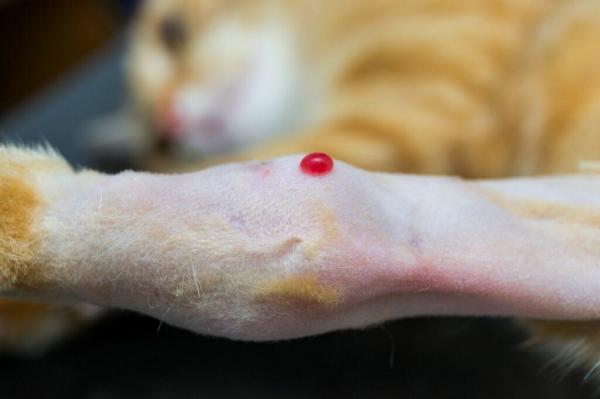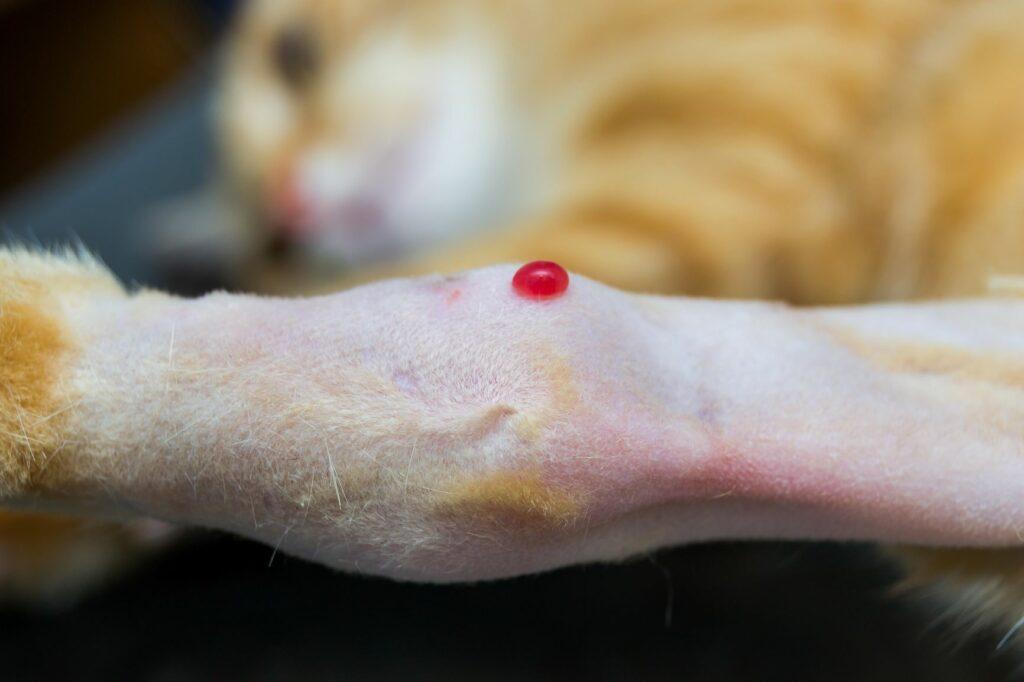My Cat's Paw Is Swollen



See files for Cats
Depending on the amount of fur your cat has on their paw, it can be difficult to tell if their paw is swollen. However, once the swelling is developed enough, it will soon be obvious. Even if you cannot see the swelling itself, there will be other symptoms depending on the underlying cause. This inflammatory process can be part of a localized problem such as a skin allergy or trauma. There are also systemic diseases which can result in swelling of various body parts, including the cat's paw.
At AnimalWised, we look at why my cat's paw is swollen. We understand the main causes, symptoms and treatment of swelling in a cat's paw by looking at the most common causes individually.
Feline plasma cell pododermatitis
A cat's paw has keratinized pads on their base and digits, both on the forelimbs (palmar or metacarpal pad) and the hindlimbs (plantar or metatarsal pad). When the swelling is localized to these pads, it is possibly due to a poorly understood pathology known as plasma cell pododermatitis (feline plasmacytic pododermatitis).
This disease is believed to have an immune-mediated origin due to the existence of hypergammaglobulinemia. This is a condition affecting lymphocytes and deposition of immune complexes (antigen-antibody) with response to treatment by glucocorticoids. However, other factors must be involved in its origin as it also responds to surgical treatment without the use of immunosuppressants such as glucocorticoids.
Cats with feline pododermatitis present with tenderness and swelling of the pads of either set of paws. They will also show signs of pain. The paw of an affected cat may also redden as they may present bleeding and ulceration. Edema, discomfort, licking of the affected area and lameness may also present.
Treatment of feline plasma cell pododermatitis
If left untreated, this disease can lead to secondary infections and can cause advanced levels of pain in cats. The entire paw can become swollen and very tender to the touch. This disease is often associated with renal amyloidosis or plasma cell stomatitis.
Treatment should include antibiotics such as doxycycline, glucocorticoids such as prednisolone. In more advanced cases, surgical removal of ulcerations may be required.

Arthritis
Arthritis is an umbrella term for various disorders which affect joints and cause swelling. The inflammation of a joint may be due to infectious or non-infectious causes. When several joints are affected, it is called ‘polyarthritis’. This is not the same as osteoarthritis which consists of a chronic and permanent degenerative disease of the joints.
The causes of arthritis in cats are varied. It can be the result of bite wounds in fights or accidents, as well as autoimmune or rheumatoid causes, viral infections (leukemia and feline immunodeficiency), osteoarthritis, bacterial infections, falls, trauma or strains.
Cats with arthritis may exhibit the following clinical signs:
- Inflammation of the joint causing a bulge or swelling of the affected leg
- Reduction or loss of mobility of the affected area
- Decrease in physical activity and movement
- Joint pain
- Joint crepitus (grating sound)
- Depression
- Muscular atrophy
- Spends more time resting
- Increased temperature in the area of the affected joint
- Lameness
- Redness of the affected paw
Treatment of feline arthritis
The treatment of feline arthritis should include non-steroidal anti-inflammatory drugs (NSAIDs) to reduce inflammation and pain in the joints. This will help to improve the symptoms of the affected cat. Supplements that help the joint, such as glucosamine and chondroitin, can also be used. In the most severe cases of arthritis, surgery may be considered as a last option.

Bone tumors
A cat's swollen paw can sometimes respond to a bone tumor of one or more bones of the limbs. The four main bone tumors are osteosarcoma, fibrosarcoma, chondrosarcoma and hemangiosarcoma. Osteosarcoma is the most common of these types of feline cancer.
These tumors can be primary if they arise directly from the bone or secondary when produced by metastases from other tumors. These cancers leading to secondary tumors include multiple myeloma of the bone marrow or transitional cell carcinoma of the bladder. Fortunately, bone tumors in cats are less aggressive than in dogs and are usually not primary tumors.
Treatment of bone tumors in cats
Cats with bone tumors of the limbs can become so weak they fracture the bone with otherwise normal activity. This can cause a lot of pain and lameness, so it is normal for the cat to not support the leg that has swelling. Primary osteosarcomas can produce metastases in the lungs and lymph nodes, although not always. When the tumor is located only in the affected limb, amputation is required. In other cases, chemotherapy and radiotherapy should be used.
To learn more about tumors and cancers in cats, take a look at our article on feline mast cell tumors.

Trauma
Although strong and agile, the curiosity of domestic cats can lead to accidents. Falling from great heights, being in a road traffic collision, getting in fights with other cats and any number of scenarios can lead to trauma to the cat. Even relatively superficial wounds can become infected and lead to inflammation. However, fractures and sprains can lead to significant swelling which can cause great discomfort. Without treatment, it is possible they will become lame.
Bacterial infections can develop into abscesses where the accumulation of pus causes the swelling. In these cases, the swelling may go down after the infection is resolved, but it is also possible they will need to be drained. The infection must never allowed to spread due to the risk of reaching the blood and causing septicemia.
Treatment of trauma in cats
If your cat has a swollen paw due to trauma, the treatment will depend on the type of trauma and extent of the damage. In small wounds on the paw or leg, they may be allowed to heal on their own, but they may require antibiotic treatment and/or drainage. For breaks and sprains, the area may need to be supported with a splint or cast. In severe cases, the cat may need to be kept in hospital due to the difficult of keeping them stable.
Pain management will also be required in cases of severe trauma. These will likely be in the form of non-steroidal anti-inflammatory drugs (NSAIDs). Not only will they help with the pain, but they can lessen the inflammation.

Edema
The paws of cats can swell due to an accumulation of fluid in them due to peripheral edema. This is an accumulation of excessive tissue fluid within interstitium, i.e. the gap between the tissues or organs of the animal. This disorder can be due to various causes, including congestive heart failure, kidney failure or in cases of hypernatremia (increased sodium levels).
At first glance, it may seem the cat does not support the paw, but does not complain or show signs of pain. This is partly due to their ability to mask pain well. However, the edema can become problematic, especially if it is on a sensitive area of the leg such as the paw. annoying.
Treatment of edema in cats
Treatment of feline edema should be based on treating its underlying cause. If necessary, diuretics may need to be administered to facilitate the elimination of the fluid accumulation.
Learn more about one cause of feline edema with our article on heart failure in cats.

Allergic reaction
Another common reason why a cat's paw may be swollen is due to an allergic reaction. Cats can be allergic to almost anything in their environment if they are susceptible, but their paws can be particularly affected. If the cat has a skin allergy to something which may be on the ground, contact with their paws can lead to the localized inflammation.
Since cats use their paws to manipulate objects in their environment, they can also damage them when they touch something which causes a reaction. For example, cats are keen hunters. They will often play with their intended prey by batting them with their paws. If this prey is an insect, they can bite or sting their paw which can lead to an allergic reaction and swelling of the area.
In some cases, these can be very serious. For example, if the cat is playing with a poisonous spider, the spider bite can lead to necrosis, intoxication or even infections of the bite wound. When this occurs, swelling of the cat's paw will not be the only symptom. You may also see serious systemic symptoms due to allergies which can result in the death of the cat. For this reason, it is important to know what antidotes you may require given the area in which you live.
In the case of bee stings, the swollen paw will be irritated, sore and inflamed. It can also produce a general allergic reaction with alterations in heart and respiratory rhythm. In severe cases, this can lead to blockage of the respiratory tract with fainting and a bluish tongue. Treatment should include antihistamine therapy in addition to removing the stinger.
When you don't know the cause of the sting or bite, but you know there are potential poisonous creatures in the area, you should take the cat to the veterinarian. This is especially the case when systemic symptoms such as lethargy, slow breathing, excessive salivation or convulsions. The treatment of the allergy will depend on the specific cause, but you can learn more with our article on poisoning in cats.
Image: animalrevista.com

This article is purely informative. AnimalWised does not have the authority to prescribe any veterinary treatment or create a diagnosis. We invite you to take your pet to the veterinarian if they are suffering from any condition or pain.
If you want to read similar articles to My Cat's Paw Is Swollen, we recommend you visit our Other health problems category.
- Gruchouskei, L., Viott, A. M., Santana, R., Giraldes, F. F., & Tostes, R. A. (2012). Feline plasmocytic pododermatite. Retrieved from: https://revistas.ufpr.br/veterinary/article/viewFile/24367/18564
- Aybar, V., et al. (2018). Clinical Manual of Feline Medicine. Ed.SM Publishing LTD. Sheffield, UK.










